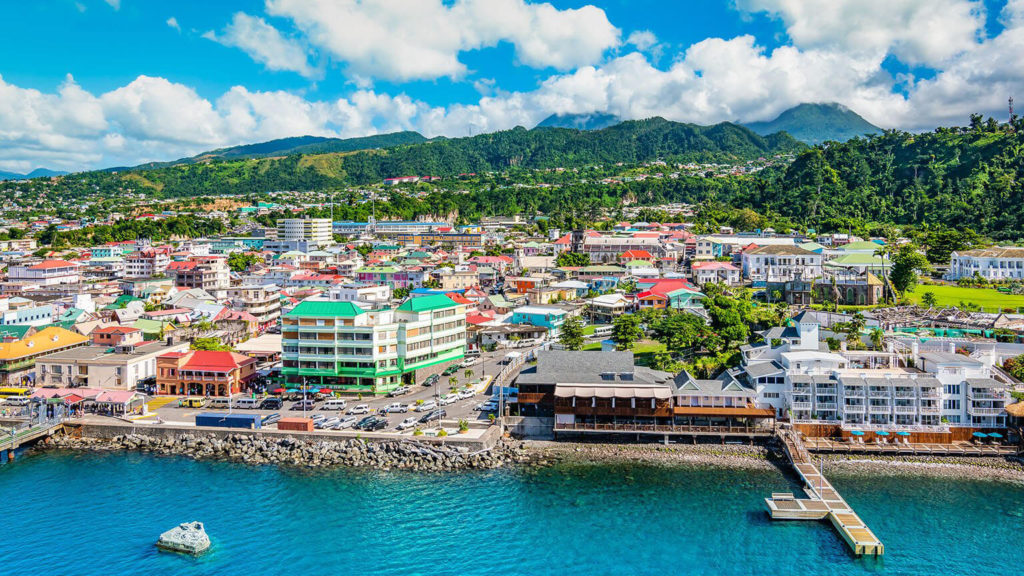Dominica is a small, fertile island in the eastern Caribbean Sea. Its closest neighbours are the French islands of Guadeloupe and Marie-Galante, to the north, and Martinique, to the south. The island was formed from volcanic activity. It has a range of high mountains covered in forests. It still has several active volcanoes.
Key facts
- Region: Caribbean and Americas
- Population: 72,000 (2018)
- Area: 750 square kilometres
- Capital: Roseau
- Joined Commonwealth: 1978, following independence from Britain
Secretariat support for Dominica
Elections
Dominica received Commonwealth Election Professionals (CEP) Initiative training in May 2018. Its election officials improved their knowledge of campaign and party financing, women’s participation and new media.
The Commonwealth sent a Commonwealth Observer Group to observer the 2019 elections in Dominica.
Human rights
At a working session in April 2019, the Secretariat helped Dominica’s Ministry of Foreign and CARICOM Affairs improve reporting on human rights under the United Nation’s Universal Periodic Review (UPR) process. Dominica decided to set up an instrument for reporting and follow-up as a result of this assistance.
Anti-corruption
In 2018-19, the Secretariat gave training in leadership and management to senior officers from Dominica’s anti-corruption agency.
Youth
From July 2016 to January 2017, the Secretariat sent an expert to Dominica to help draft a new National Youth Policy. The Secretariat also helped Dominica improve its policies to encourage young people to set up businesses.
Trade
The Commonwealth’s Geneva office helped Dominica build skills in international trade talks.
Blue Charter
Dominica is a member of the Marine Protected Areas Action Group.
Dominica and the Commonwealth
The current Secretary-General of the Commonwealth, The Rt Hon Patricia Scotland QC, is the 6th Commonwealth Secretary-General.
The Secretary-General was born in Dominica and was their candidate for the post at the Commonwealth Heads of Government Meeting (CHOGM) in Malta in 2015.
She is the 2nd Secretary-General from the Caribbean and the 1st woman to hold the post.
Before being discovered by Christopher Columbus in 1493, Dominica’s mountainous natural beauty was originally enjoyed by the Carib Indians who made the island their home in the 14th century. The Caribs called their sunny isle Waitukubuli, meaning ‘Tall is her body, and some Carib descendants remain in Dominica today – the last surviving community of this indigenous group.
Following Columbus’ arrival, the island became known as Dominica, taking its name from the day he landed (Dominica is Latin for Sunday). France colonised it in the 1600s, before, in 1805, the island became a British possession, remaining under British rule until the late 1960s. During both world wars thousands of Dominicans volunteered to fight in Europe for the Allies and the country provided a place of safety for Free French refugees fleeing the Vichy-controlled French islands.
Dominica has been nicknamed the ‘Nature Isle of the Caribbean’ on account of its stunning natural features, not least Boiling Lake, the appropriately named hot spring – the second largest in the world.
Since 1978, the island has enjoyed full independence although self-rule has been somewhat stormy, with two coup attempts by leftist members of the island’s Defence Force during the early 1980s.
The arrival of Hurricane David in 1979 brought mass chaos as the immense tropical storm damaged three quarters of the island, destroying homes and killing 42 people. A bus still remains to this day crushed under a storm-felled tree in Rousea’s Botanical Gardens.
After the 1980 elections Dominica appointed Eugenia Charles, the Caribbean’s first female prime minister.
Politically, the early 2000s proved eventful, with two Prime Ministers – Roosevelt Douglas and Pierre Charles – both dying while in office. Since 2004, Roosevelt Skerrit has been leading the country and remains a popular figure.
In recent years, Dominica has developed a close, if controversial, relationship with Japan, which has provided extensive development aid including a modern fisheries complex. In exchange, Dominica now supports Japan’s much criticised efforts to undermine international controls on whaling. Nevertheless, given the island’s serious economic problems, the deal enjoys wide popular support.
Did you know?
• Dominica’s national bird is the Sisserou parrot, which features on the national flag.
• The Commonwealth of Dominica has emerged as a major international offshore financial centre thanks to its low-tax regime.
• Playwright and novelist Jean Rhys was born in Dominica, which features as the ‘honeymoon island’ in her best known work, Wide Sargasso Sea.
“Isle of Beauty, Isle of Splendour”
Isle of beauty, isle of splendour,
Isle to all so sweet and fair,
All must surely gaze in wonder
At thy gifts so rich and rare.
Rivers, valleys, hills and mountains,
All these gifts we do extol.
Healthy land, so like all fountains,
Giving cheer that warms the soul.
Dominica, God hath blest thee
With a clime benign and bright,
Pastures green and flowers of beauty
Filling all with pure delight,
And a people strong and healthy,
Full of godly, rev’rent fear.
May we ever seek to praise Thee
For these gifts so rich and rare.
Come ye forward, sons and daughters
Of this gem beyond compare.
Strive for honor, sons and daughters,
Do the right, be firm, be fair.
Toil with hearts and hands and voices.
We must prosper!
Sound the call, In which ev’ry one rejoices,
“All for Each and Each for All.
Caribbean festivals are common during the first two months of the year, while culture-themed events occur from October to November in Dominica. Regardless of the type of celebration, you can always expect a lively, colorful, and fun atmosphere in Dominica holidays filled with music, dancing, food, and local culture.
Carnival
A major highlight of the island, Carnival is celebrated a week before Ash Wednesday. Unlike other Caribbean islands, Dominica’s celebration is less commercialized. You can expect local pageants, dancing, and music during the festival.
Dominica Festival of the Arts
Every year from April through June, Dominica celebrates its Festival of the Arts. Gallery openings, theatrical performances and concerts take place throughout the island on a weekly basis.
Jazz n’ Creole
Happening in May, this festival is hosted in Fort Shirley, Cabrits National Park which draws participants from other French islands to Dominica. It showcases local jazz musicians who perform live.
Caribbean Endemic Bird Festival
Held yearly in April or May, this eco festival aims to increase awareness of Caribbean birds. Lectures and bird watching tours are part of the roster of activities.
Giraudel-Eggleston Flower Show
This event showcases Dominica’s natural beauty. You are welcome to discover and sample some of the best vegetables and fruits of the island, as well as admire creative flower arrangements and displays.
Dive Fest
One of the Caribbean’s longest-running scuba diving festivals, Dive Fest is held annually for nine days and features swim races, kayaking, a treasure hunt, and canoe contests. It usually takes place in July and aims to educate visitors on the most popular diving and water sports attractions on the island.
World Creole Music Festival
Held annually in October, this is one of the most anticipated festivals in the entire Caribbean. Windsor Park Stadium in Roseau is the center of the action which invites different bands to perform live each night.







